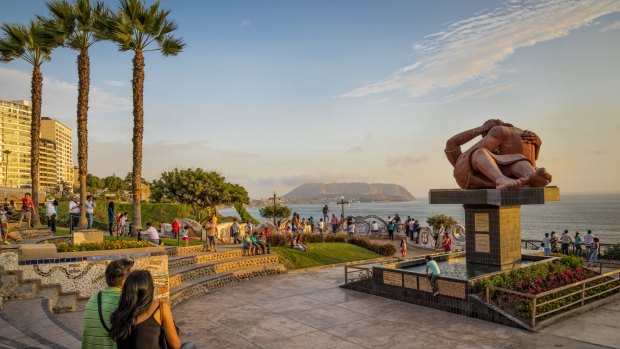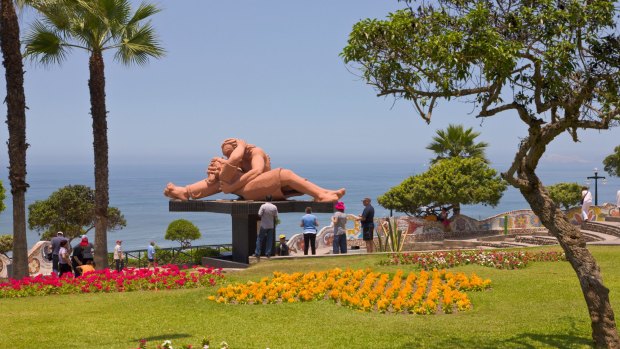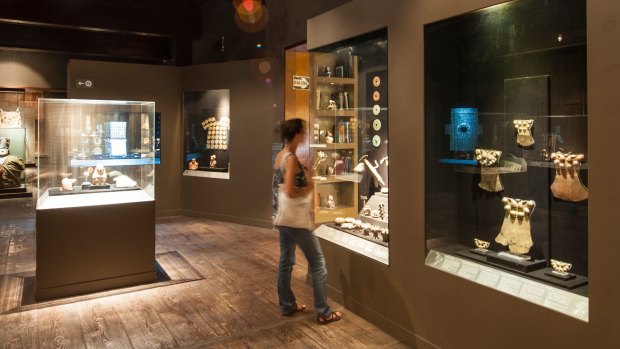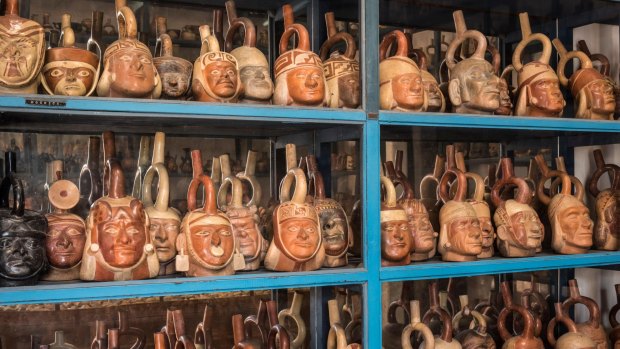This was published 8 years ago
Larco Museum, Lima: 50 shades of clay at erotic museum

Parque del Amor in Miraflores, Lima.Credit: Greg Vaughn
They say sex sells. But sometimes it just gets you into trouble, if the attendant following me is anything to go by. I'm in the erotic pottery section of Lima's Larco Museum – scribbling notes, taking photographs, pressing my nose against the glass – when he approaches. "Madam," he says, with one eyebrow raised, "can I help you?" I mumble something about being a journalist on a serious assignment, before scampering off to the on-site Café del Museo for a much-needed Pisco Sour.
Sitting under the shady terrace I scroll through my images: an adults-only collection of topics such as "the union of animals, fruits and deities" and the "sexual activity of the dead". I like to think I'm open-minded, having giggled at the giant wooden phalluses in Thailand and barely blinked at the frisky frescoes from ancient Pompeii, but these ceramic pots take things to a whole new 50 shades of clay.
Row after row of 1500-year-old erotic ceramics and pottery reveals the ancient Andean people's explicit and often humorous takes on sexuality, including their rituals with the gods and the underworld. While the collection gives valuable insights into fertility, motherhood and agricultural practices, for the layperson it's hard to see beyond the Kama Sutra contortions.

The Parque del Amor with its El Beso (The Kiss) sculpture in Miraflores, Lima.Credit: Alamy
Housed in an 18th-century mansion and built over a 7th-century pyramid, the Larco Museum is home to one of the world's largest private collections of pre-Columbian art. Founded in 1926 by Rafael Larco Hoyle, the collection includes artefacts from the Cupisnique, Chimú, Chancay, Nazca and Inca cultures, including Moche portrait vessels, Wari weaving, and artworks connected with human sacrifice.
Separate to the main museum is a back storeroom, a dusty warehouse with more than 45,000 meticulously catalogued objects, which, unlike most other museums, visitors are allowed to wander through. Separate again is the Erotic Gallery, but it takes some finding – away from the main museum, down a winding walkway, with few signs (I saw one) or information. Even the website is coy.
Though I'm in Lima on a group tour with Scenic Tours I've snuck away on my own during some free time, after a tip from our tour director. The combination of organised activities, such as a tour of an archaeological site or dinner with a local family, together with free time is providing the perfect introduction to a city I'd long thought of as nothing more than a stop over. A sex lesson is a bonus.

Pre-Columbian artefacts on display in the Larco Museum.Credit: Alamy
My morning had started chastely enough, at the Pachacamac archaeological site 35 kilometres south-east of the city where, among other things, I learn that ancient pilgrims had to abstain from chilli, salt or "intimate relations" for 20 days before visiting. Fortunately, entry requirements are more lax now than in AD200, when the area was established as a ceremonial centre in honour of the god creator of the universe. Since then, each successive culture has added its own temples, pyramids and chambers to the multiple layers inside the complex
During the Inca period, Pachacamac was one of the most important pilgrimage centres of the empire, given that it housed the famed wooden idol the Oracle of Pachacamac. Today the site is a bleached landscape; drained of colour the ruins look like they are being sucked back into the earth. Everywhere, ancient dry walls rise and fall with the contour of the land, pale as parchment and bisected by terraces, which slouch like tired shoulders towards the rough-hewn roads.
The sun is a merciless fireball as we follow our guide Ricardo along dusty streets, passing the First and Second Peripheral Walls, Temple of the Sun and Pyramid with Ramp. "According to studies by NASA engineers the temple site is considered a powerful 'magnetic' centre," Ricardo explains. "There is an unusual energy here which has been recognised for 2000 years."

Huaco pottery vessels of the pre-Columbian Mochica (aka Moche) culture in the Museo Larco in Lima. The faces are portraits of real people. Credit: Alamy
From a hilltop he points out the House of the Chosen Women, where, during Incan times, Virgins of the Sun were selected for their beauty and breeding to live in a temple convent under a vow of chastity. "For the first few years they were tutored by the High Priestess, learning to weave and prepare ceremonial foods," explains Ricardo "But eventually they became either concubines, the wives of nobles, or were sacrificed in honour of the sun."
Back at the Larco Museum I learn more about human sacrifice, where victims were offered to placate the wrath of the gods or to accompany the dead into the next life. Seen as an act of giving and receiving, the sacrifices were often part of religious ceremonies where bloodletting was tied to crop success and fertility.
After all that sex and sacrifice, even the dishes at the Café del Museo sound suggestive: delicate duck thighs cooked in its own juices, slow-roasted chicken thighs served with buttery French beans, tenderloin in a wild funghi sauce. Sitting at the outside terrace I order a second Pisco Sour and a sinfully rich Dulce de Leche crepe smothered in double ice-cream. Overhead a canopy of bougainvillea flowers flutter in the sun, their scarlet petals delicate butterflies against pale sky. Beyond, couples stretch out on the grass, enjoying the sculpture garden and a glass of wine. As first dates go, this would take some beating.
With the remainder of the afternoon at leisure I set out to explore the leafy district of San Isidro surrounding the hotel Swissotel Lima, where we are staying. There are more than 300 archaeological sites in Lima, so I don't have to walk far before stubbing my toe on a ruin. The restored pre-Incan Huaca Huallamarca pyramid, with its expansive grounds and small museum, is practically next door.
Just before sunset I catch a taxi to the cliff-top district of Miraflores, which roughly translates as "look at the flowers". Unfortunately, I'm having trouble looking at anything, flowers or otherwise, due to the thick fog cloaking the cliffs. Known as garua, this melancholy mist that rolls in each winter has inspired many writers. It is "the strangest, saddest city thou canstsee," wrote Herman Melville in Moby Dick. "For Lima has taken the white veil; and there is a horror in this whiteness of her woe."
Just as I'm about to give up, the fog lifts, revealing a massive sculpture of two lovers entwined in a passionate kiss silhouetted against an ocean of lavender and gold. Known as "El Beso" (The Kiss) by Victor Delfin, the sculpture is the centrepiece of Parque del Amor (Love Park). Surrounded by walls of romantic quotes scripted in mosaic tiles the sculpture celebrates the lovers who gather here each evening.
Strolling along the promenade I'm stopped by an elderly couple who ask me to take their photograph. As I push the shutter the man grabs his partner, kissing her fully on the lips. As I'm learning, in Lima, sexiness is everywhere.
TRIP NOTES
MORE INFORMATION
GETTING THERE
LAN Airlines operates seven one-stop flights each week from Sydney to Santiago, Chile, with onward connections to Lima, Peru. Travellers from Melbourne can connect to their LAN Airlines flight to Santiago in Sydney. Phone 1800 126 038, see lan.com
TOURING THERE
Scenic offers a 24-Day South American Adventure & Amazon Cruise, which includes Peru, Argentina and Brazil. Enjoy a luxury three-night Amazon cruise before a two-night stopover in Lima. Explore Peru's Incan heritage at the Sacred Valley, the World Heritage site of Machu Picchu and Cuzco plus Lake Titicaca, Iguazú Falls and the cities of Buenos Aires and Rio de Janeiro. Prices from $17,795 a person twin share.
Earlybird offers out now for 2016 bookings made by 30 September – buy one airfare and your partner will fly free, including air taxes of up to $180. Phone 1300 723 642, see scenictours.com.au.
The writer was a guest of Scenic Tours and LAN Airlines.
See also: Inside Europe's most erotic hotel room
See also: The temples filled with pornography ... or is it art?
Sign up for the Traveller Deals newsletter
Get exclusive travel deals delivered straight to your inbox. Sign up now.